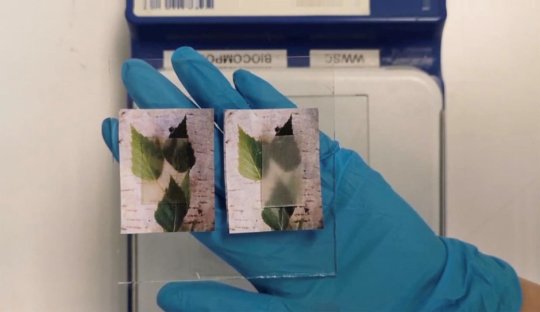[ad_1]
Wood may seem more at home in log cabins than modern architecture, but a specially treated type of timber could be tomorrow’s trendy building material. Today, scientists report a new kind of transparent wood that not only transmits light, but also absorbs and releases heat, potentially saving on energy costs. The material can bear heavy loads and is biodegradable, opening the door for its eventual use in eco-friendly homes and other buildings.
The researchers will present their results today at the American Chemical Society (ACS) Spring 2019 National Meeting & Exposition.
“Back in 2016, we showed that transparent wood has excellent thermal-insulating properties compared with glass, combined with high optical transmittance,” says Céline Montanari, a Ph.D. student who is presenting the research at the meeting. “In this work, we tried to reduce the building energy consumption even more by incorporating a material that can absorb, store and release heat.”
As economic development progresses worldwide, energy consumption has soared. Much of this energy is used to light, heat and cool homes, offices and other buildings. Glass windows can transmit light, helping to brighten and heat homes, but they don’t store energy for use when the sun goes down.
Three years ago, lead investigator Lars Berglund, Ph.D., and colleagues at KTH Royal Institute of Technology in Stockholm, Sweden, reported an optically transparent wood in the ACS journal Biomacromolecules. The researchers made the material by removing a light-absorbing component called lignin from the cell walls of balsa wood. To reduce light scattering, they incorporated acrylic into the porous wood scaffold. The team could see through the material, yet it was hazy enough to provide privacy if used as a major building material. The transparent wood also had favorable mechanical properties, enabling it to bear heavy loads.
Building on this work, Montanari and Berglund added a polymer called polyethylene glycol (PEG) to the de-lignified wood. “We chose PEG because of its ability to store heat, but also because of its high affinity for wood,” Montanari says. “In Stockholm, there’s a really old ship called Vasa, and the scientists used PEG to stabilize the wood. So we knew that PEG can go really deep into the wood cells.”
Known as a “phase-change material,” PEG is a solid that melts at a temperature of 80 F, storing energy in the process. The melting temperature can be adjusted by using different types of PEGs. “During a sunny day, the material will absorb heat before it reaches the indoor space, and the indoors will be cooler than outside,” Montanari explains. “And at night, the reverse occurs — the PEG becomes solid and releases heat indoors so that you can maintain a constant temperature in the house.”
The team encapsulated PEG within the de-lignified wood scaffold, which prevented leakage of the polymer during phase transitions. They also incorporated acrylic into the material to protect it from humidity. Like their earlier version, the modified wood was transparent, though slightly hazy, and strong, but had the added bonus of storing heat.
The researchers point out that the transparent wood has the potential to be more environmentally friendly than other building materials such as plastic, concrete and glass. In addition to its thermal-storage capabilities, the transparent wood could be easier to dispose of after it has served its purpose. “The PEG and wood are both bio-based and biodegradable,” Berglund notes. “The only part that is not biodegradable is the acrylic, but this could be replaced by another bio-based polymer.”
Now, the focus turns to scaling up the production process to be industrially feasible. The researchers estimate that transparent wood could be available for niche applications in interior design in as little as five years. They are also trying to increase the storage capacity of the material to make it even more energy-efficient.
[ad_2]















